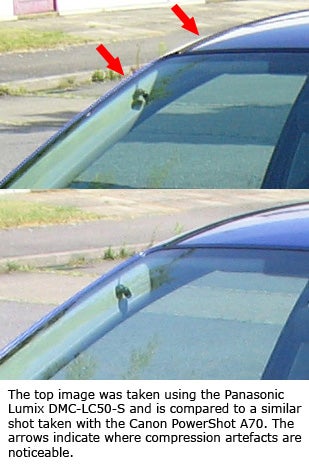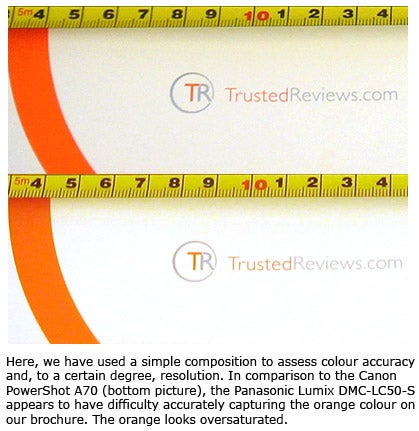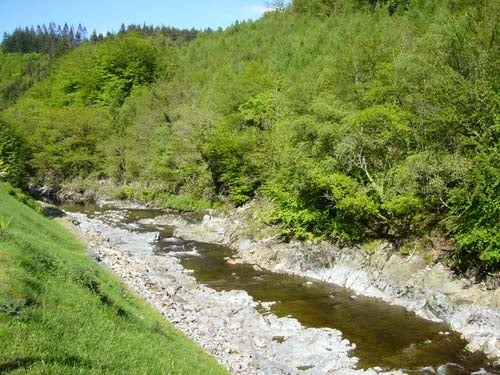Panasonic Lumix DMC-LC50-S Digital Camera Review
Panasonic Lumix DMC-LC50-S Digital Camera
Panasonic has produced a 3.2 megapixel camera at an amazing price, but have too many corners been cut?

Verdict
Key Specifications
- Review Price: £150.00
Panasonic isn’t the first name that you’d think of when it comes to digital cameras, but this isn’t something that has gone unnoticed in the Panasonic board room. Since Panasonic has no real history or branding in the camera market, it has done the smart thing and partnered itself with a company that does.
Panasonic has teamed up with photography legend Leica to produce the Lumix range of digital cameras. This kind of dual branding has worked very well for Sony, which partnered itself with Carl Zeiss in order to gain some instant kudos in photography circles. The Sony technology coupled with the Carl Zeiss optics, made for some excellent digital cameras and has put Sony on a par with Canon, Nikon, Fuji Film and Olympus, in all the digital camera sectors, bar SLR. The Panasonic model is pretty much identical to Sony’s with Leica making the lens and Panasonic producing the hardware that surrounds it.
The LC50 is Panasonic’s entry level camera and with a price of £149.98 including VAT from Panasonic’s own online shop, it looks like a real bargain on the surface. What’s most impressive is that even at this price you’re getting a Leica lens, whereas the Sony entry level cameras don’t tend to come with Zeiss lenses. With this in mind, the big question is whether Panasonic has had to make any major compromises to squeeze in the Leica hardware and branding at such a low price point.
Let’s start with the basics, the LC50 has a 3.2 megapixel CCD capable of producing images at a resolution of 2,048 x 1,536. The Leica lens offers 3x optical zoom functionality that’s equivalent to 35 – 105mm in 35mm language. There’s also a 9x digital zoom option, but as always I’d advise switching the digital zoom off since you’ll get better results cropping and zooming under Photoshop or PSP.
The first and most obvious sign that this is a budget camera is the plastic body. I always prefer metal bodied cameras since they’re a bit more robust, and the cool feel of a metal body in your hands inspires more confidence. That said, at this price point I’m not going to dwell on the plastic body too much.
The LC50 can’t be described as large, but it’s not small either – face on this camera looks quite diminutive, but look at it in profile and you’ll see that it’s actually quite chunky. Like most digital cameras it’s finished in silver and looks pretty good. Ergonomically the LC50 is easy to hold and all the controls on the back have been positioned so they’re out of the way of your thumb.
Most of the controls are located on the back of the body, with only the shutter release, zoom control and power switch on the top. Strangely, the power switch is just that – a switch. To power the camera on you slide the switch to the right and to power it off you slide it back to the left. It’s been a while since I’ve seen a power switch like this, with almost every recent camera sporting a button that toggles power on and off.
At the rear you’ll find a dial control to select the record or playback mode. In the centre of the dial is a button that activates the burst mode – this allows you to take around three pictures per second. The results from the burst mode were pretty good, and you should be able to get some good action shots with it.
Below the dial is a four-way button. Pressing this button to the left activated the self timer which has two settings. The ten second timer gives you enough time to get yourself into the picture, while the two second timer avoids camera shake when taking pictures without a flash with the camera mounted on a tripod or solid surface. However, how useful this will be is debatable since the LC50 doesn’t have a shutter priority setting. The only way you can get a long shutter is to turn the flash off and hope for the best. What’s really strange is that you have to turn the automatic ISO setting off to get a shutter speed longer than 1/8 sec and you have to switch to “night portrait” mode to get anything longer than two seconds. With all this in mind, Panasonic may as well have included a manual shutter priority, since it would be no more complicated to use. Assuming you get all the settings right, the LC50 will keep the shutter open for a maximum of eight seconds.
Pressing the four-way rocker pad to the right cycles through all the flash modes, while pushing it up lets you set exposure compensation which you can set between –2 and +2 in 1/3 steps. Finally, pushing the pad down will allow you to review the last picture taken, while in record mode.
The final three buttons are delete, display and menu. The delete button is used to delete images that you’re not happy with, but this process is hardly intuitive. If you want to delete an image you press the delete button while viewing it, you are then given a “yes” or “no” option for the delete. However, for me at least, I assumed that highlighting “yes” and pressing delete again would erase the offending image, but this is not the case. To delete the selected image you have to highlight “yes” then press down on the four-way rocker pad (as well as the review function, pressing down also acts as a “set” function when in a menu). If however you try, as I did, to press the delete button when you’ve highlighted “yes”, you get the option of multiple delete or erase all.
The display button cycles through the modes of the LCD display – options are display with no information, display with information (quality setting, flash setting etc.), display with a composition grid or finally with the display off. The menu button, unsurprisingly takes you into the configuration menus.
The LCD display is very good, with a bright clear image and fast response time. You can even adjust the brightness of the display to suit your shooting conditions.
I spent quite a lot of time with the LC50 and used it in a number of environments. I took it up to North Wales with me on a mountain biking trip, used it every day for the odd snap here and there and even took it with me to Computex in Taipei where it was responsible for all of the shots in my show reports. After extensive use I came to know all of the LC50’s strengths and weaknesses.
In its favour, the LC50 is reasonably small and light. Even though it’s a bit chubby I managed to fit it in my trouser pocket so it was ready for action at the drop of a hat. It’s also reasonably fast to turn on, but nowhere near as quick as the Canon Digital IXUS 500 I reviewed a little while ago.
On the underside of the camera is the battery compartment. There’s no rechargeable battery pack in the box, and power is supplied by two standard AA batteries. The ability to use standard alkaline batteries is not a bad thing though, since you can buy them anywhere and you don’t have to worry about remembering to charge the camera up.
On the left of the chassis is the memory card slot which accepts both SD and MMC cards – you get a 16MB SD card in the box. Also on the left are the DC in and USB/Video out port. The latter is pretty clever, and Panasonic provides both cables.
As well as still images, the LC50 can record movies. There’s no built-in microphone so you won’t get any sound with your moving masterpiece. The movie resolution is 320 x 240 and you can choose either 10fps or 30fps depending on whether you want to go for a small file size or higher quality.
Some of the controls are familiar, like the focusing method. All the cameras I own are made by Canon, so for me, the process of half-pressing the shutter release button to auto-focus is second nature. This process also makes it easy to focus on your subject, without the subject needing to be at the centre of the frame. Thankfully, Panasonic has adopted this auto-focus method for the LC50, making it, in theory at least, easy to use. Unfortunately, the LC50 has the worst auto-focusing I’ve ever seen on a camera.
Using the LC50 I found myself getting constantly frustrated when trying to focus on specific subjects and finding that the camera was just unable to get a good focus lock. Making matters even worse is the lack of a manual focus option, so you can’t even take matters into your own hands. To be fair, in very well lit conditions the auto-focus worked well enough, but trying to take product shots while wandering around Computex proved to be a nightmare. Now, having taken my old Canon G1 to CES and the Digital IXUS 500 to CeBIT, I know that this shouldn’t be an issue. Both of these cameras managed to focus on whatever I pointed them at, even with the less than perfect lighting conditions. There is a menu option to use “spot focusing”, but turning this on didn’t improve matters. Coincidentally, you can set the automatic review mode to zoom the image you’ve just taken to 4x, and to quote the manual “This mode is useful to confirm the focus”.
Surprisingly for an entry level camera, the LC50 allows you to set the ISO level from 50 all the way to 400. Personally I prefer to use as low an ISO setting as possible to reduce the possibility of CCD noise affecting the images. Unfortunately CCD noise seemed to be an issue no matter what ISO setting was used. Looking at images with strong tones and colours, CCD noise could clearly be seen where surfaces should have been smooth and solid.
But CCD noise was only part of the problem when it came to image quality. The LC50 has only two image quality settings – fine and standard. On the plus side, there is actually very little quality difference between fine and standard settings, so you might as well use standard which produces images of around 500KB as opposed to fine which produces images of around 1.2MB. That said, the only reason that there is little difference between fine and standard, is because the quality of images taken in fine mode is quite poor. I can only assume that even in fine mode, a great deal of compression is still being applied, because images suffer greatly from compression artefacts. Looking at the test image of the car, you can see that the diagonal line of the windscreen is plagued with stepping and compression artefacts on the LC50, while the curved line on the roof trim is equally bad. For comparison we took a similar picture using a Canon PowerShot A70 (winner in last year’s digital camera group test), where the stepping on the windscreen line is minimal and the roof trim is completely smooth.
Unfortunately the LC50’s image quality shortcomings don’t even end there. Colour accuracy also seemed to be beyond the LC50, and our studio test shot shows that the orange on the TrustedReviews brochure looks decidedly red, while in the image taken with the Canon A70 it looks, well, orange.
It’s not all bad though. The pictures I took up in Wales came out ok, so it’s clear that the LC50 can take reasonable photos in good conditions. So if you’re looking for a cheap, point and shoot camera, the LC50 can more or less hold its own.
Given Panasonic’s strong consumer electronics pedigree and Leica’s legendary photo-optic history, I expected the LC50 to be a great little camera, but unfortunately that didn’t prove to be the case. It’s worth remembering that this camera represents the bottom of the Lumix range, and I assume that the quality would improve as you moved up the model ladder. Hopefully I’ll have a chance to look at a higher-spec Lumix to confirm this.
There’s no doubt that pitching the LC50 at under £150 will attract a lot of first-time digital camera buyers, and to be fair it is a great price for a 3.2 megapixel device. However, a quick look around the web revealed that the Canon PowerShot A70 can be had for less than £10 more, and in this case it would be money well spent.
”’Verdict”’
The Panasonic Lumix DMC-LC50-S is a very cheap 3.2 megapixel digital camera, but the poor quality images, auto-focusing problems and lack of manual settings make it seem like a false economy.



”’This shot taken in Snowdonia shows that the Lumix can manage a decent photo under the right conditions.”’
Trusted Score
Score in detail
-
Value 7
-
Image Quality 5
Features
| Camera type | Digital Compact |
| Megapixels (Megapixel) | 3.2 Megapixel |
| Optical Zoom (Times) | 3x |

